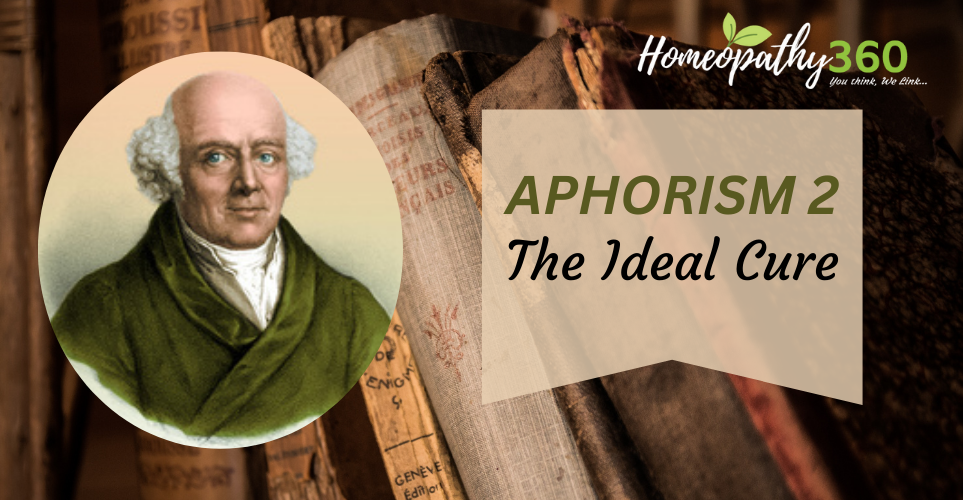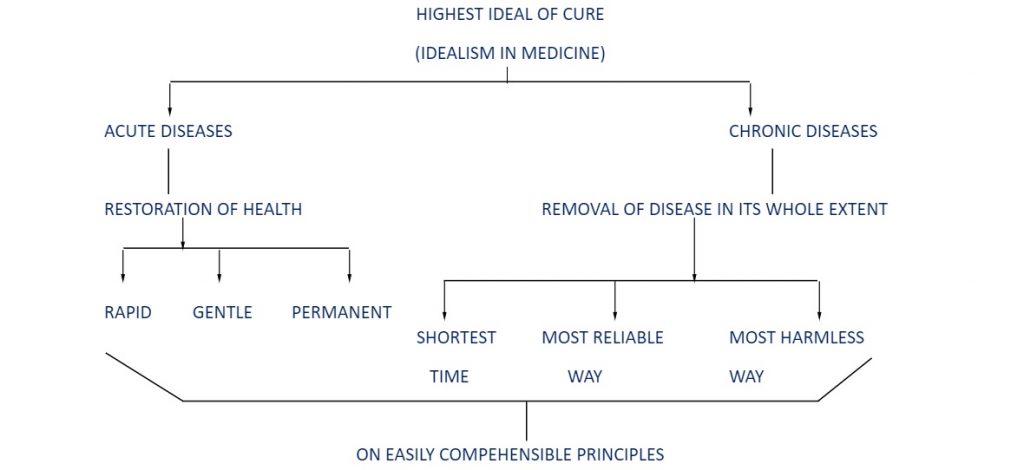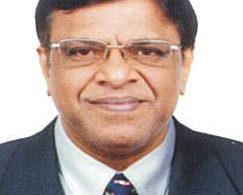
Hahnemann discussed the mission of the physician in the very first aphorism of his Organon of Medicine. In the second aphorism, he moves forward and guides us about the best possible cure, i.e., the highest ideal of cure.
Hahnemann states aphorism 2 as:
“The highest ideal of cure is rapid, gentle and permanent restoration of the health, or removal and annihilation of the disease in its whole extent, in the shortest, most reliable and most harmless way, on easily comprehensible principles.”
This can be understood in a comprehensive manner with the help of the following flow chart:

The mission of the physician, as stated by Hahnemann in §1 of his Organon, is to CURE. For cure, certain criteria have to be fulfilled, which make it an ideal cure.
Dr BK Sarkar in his book, ‘Hahnemann’s Organon of Medicine’ writes that these criteria were first enunciated by a Greek physician, Asclepiades (124 B.C.) also styled as the “Hippocrates of chronic disease.” His motto was “cito, tutu, et jucunde”, i.e., disease should be treated speedily, safely and agreeably.
The idea of permanent restoration of health and not mere temporary abeyance of diseased condition or subsequent appearance or the unhealthy state in newly altered forms, in case of an ideal cure finds its parallel in the ‘Charaka Samhita’ as-
‘That method of treatment which annihilates an existing disease syndrome but gives rise to another new set of symptoms is not the method for an ideal cure; whereas that method which removes a symptom-complex without exciting any other in its stead, is the ideal one.’ (Sutrasthanam, Charaka-Samhita)
The highest target for a physician should be to cure the patient. So, in §2 Hahnemann talks about the highest ideal of cure in both, acute and chronic diseases.
HIGHEST IDEAL OF CURE IN ACUTE DISEASES
Acute illness is an illness of rapid onset and short duration. It has more or less a fixed duration and it terminates either in recovery or death.
So, we must plan a treatment in which health can be restored or brought back to normal in such a way that it is rapid, gentle and permanent.
Let us elaborate these terms (in bold):
Rapid
Origin from Latin, ‘Rapidus’ – ‘Rapere’ meaning Seize, Rush.
Meaning- having great speed; done or completed in a short time; fast
By rapid, it means that an ideal cure should take the least possible time. Ideal cure should come fast. But an ideal time for curing a particular case, is not for us to decide. Ideal time depends upon the individual response in each case. We should just make our best efforts towards curing each patient as early as possible.
Gentle
Gentle means ‘Not harsh or severe; mild and soft‘.
By gentle it means that cure should be without any side effects. It should not be harsh or damaging in any way. As Hippocrates said – ‘Primum Non Nocere’ – ‘First of all do no harm.’
Hahnemann had witnessed the torture and pain which patients went through, due to the so-called medical treatment done by physicians of his time – like purgation, leeching, venesections etc. So, he emphasized on the fact that a patient should be relieved of his sufferings in a gentle, painless way, and not by inflicting upon him some new, extra suffering.
The method of cure should be as painless and harmless as possible. The disease itself is a suffering, so giving a harsh treatment would worsen the sufferings of the patient. Therefore, painful treatment methods should be avoided.
Permanent
By ‘cure’, Hahnemann means not just the temporary restoration of health, but a continuous care of the patient, so that there is no suffering thereafter – either immediate or remote; and health is preserved.
Hahnemann defined ‘Cure’ in his ‘Materia Medica Pura’, in the chapter on ‘China’, as – ‘Recovery undisturbed by after sufferings’.
Cure is not worth the name if the health is not restored permanently. A temporary restoration of health to be followed by suffering of any sort, falls short of the ideal cure.
If some suffering remains or returns after the treatment, it is not ‘cure’. Therefore, to achieve idealism in medicine, the physician has to treat the patient upto the removal of underlying cause. (refer §5- chronic miasm)
Thus,
In acute diseases, cure should be permanent. It should be a recovery undisturbed by after suffering. There should be a permanent removal of disease in the most rapid, gentle and permanent manner.
Next, Hahnemann talks about removal of the state of suffering in its whole extent. This relates to the holistic conception of the organism. Suffering is manifested by various kinds of symptoms amongst which some may be extremely painful while others may be least painful. But every symptom displays a deviation from the state of health and each symptom needs to be removed to cure any disease in its whole extent. In order to achieve the state of heath and cure, all the perceptible symptoms, both subjective and objective need to be removed.
For Hahnemann, curing a disease meant to reverse the whole process in such a way that the infection and pathology disappears and the patient gets back to his/her healthy state.
HIGHEST IDEAL OF CURE IN CHRONIC DISEASES
Chronic: Greek – ‘chronos’ – Time
Meaning – continuing for a long time (period); prolonged; lingering
Chronic diseases have characteristics such as:
- Slow development takes place (Slow onset)
- Prolonged duration
- It never terminates on its own – it goes on till the end of lifetime of a person or till a proper antimiasmatic treatment is given
- Have a miasmatic background, – psora, syphilis, sycosis (which are a fundamental cause for chronic diseases)
The vital force is capable of fighting the disease but for a limited period of time and when this becomes weak, it means, the body’s immunity has become weak, to fight the foreign organism that has entered the body.
Vital force is capable of overpowering and annihilating the acute diseases. But it is not capable of annihilating the chronic diseases without the assistance of medicines. A chronic disease has to be tackled for long as it persists for long and can only be treated using medicines. Therefore, when health is restored, it should be of the ‘whole’. This restoration should be in shortest time, most reliable way and most harmless way.
Let us elaborate these terms (in bold):
Shortest time
Short – Having little extension in time; of limited duration; brief
In chronic cases, Hahnemann talks about time, that is, shortest possible time. In case of a chronic disease, the cure may not be as rapid as in an acute disease, but it should be affected in a brief period – the minimum possible time taken.
Most reliable way
Reliable means ‘trustworthy, dependable’.
In homeopathic terms, a cure will be said to be reliable if there is no relapse!
So, for such a cure, the medicine which is employed for the treatment of sick individual should not be based on mere speculation, guesswork, hypothesis or opinion. It should have a sound principle behind, which is arrived at, only after careful observation, experimentation and further verification.
Dr BK Sarkar writes in his book, ‘Hahnemann’s Organon of Medicine’, that, “…The art of healing must be based on scientific principles deducted from observations, generalizations and experimental verifications. A therapeutic law is to be discovered and treatment must be based on the applications of that law…”
Most harmless way
In an attempt to bring about a cure in the shortest possible time, one should not deviate from another very important criteria to be fulfilled for an ideal cure, that is, the medicine given should not hurt or harm the patient in any way. The dose should be very minute so that it does not produce any undesirable effects, as during a disease, the person becomes much more susceptible to any external influence.
A physician’s aim should be to cure the patient and not harm the patient in any way.
EASILY COMPREHENSIBLE PRINCIPLES
Comprehensible – Capable of being comprehended or grasped by mind; Understandable; Conceivable
Whether the disease is acute or chronic, the method of cure which is ideal, should be based on certain principles which can be easily understood by anyone with sound senses.
Both acute and chronic diseases should be cured on the basis of easily comprehensible principles.
According to Hippocrates, there are only 2 such principles which can be easily understood – similia and contraria
Hahnemann has referred to them in §22 of his Organon and emphasized that cure should be based on only these two principles which are very easily and clearly understandable.
Before ending I would like to add on here that Hahnemann talks about ‘ideal’ cure in this aphorism. Ideal means a standard of perfection or excellence; an ultimate object or aim of endeavor; goal. But in real practice achieving an ideal cure is not possible every time. The highest target for a physician should be to cure the patient, but practically every cure is not going to be ideal.
There will be mistakes in selecting the similimum and the correct potency, there will be cases which could be incurable, or there will be patients who do not take care of their health and/or follow the advice of the physician. But our aim should always be to attain the ideal and give the best treatment possible to each patient who comes to us for the cure of his/her acute or chronic disease. We might not be successful in every case but we should not be disappointed with that and strive to stay on the path of achieving the ‘ideal’.





